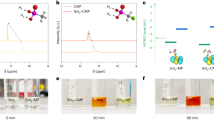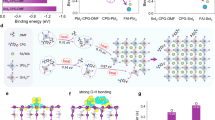Abstract
Tin-based perovskite solar cells (TPSCs) are among the best candidates for lead-free photovoltaic technology owing to their low toxicity and high theoretical efficiency. However, the efficiency and stability of TPSCs lag far behind their lead counterparts because of the poor controllability of perovskite film growth and the intrinsically easy oxidation of Sn2+. Here we synthesize two pyridyl-substituted fulleropyrrolidines (PPF) with cis (CPPF) and trans (TPPF) configurations and use them as precursor additives. The spatial configurations of the CPPF and TPPF greatly affect their electron density distributions and interactions with perovskite components. Compared with the CPPF, the TPPF has spatially separated pyridine groups that can catch more perovskite colloids through coordination bonds, thus slowing the perovskite crystallization process. The resultant perovskite film displayed better crystal orientation and compactness. The TPPF also remains located at the grain boundaries, improves the interface energy level alignment and suppresses Sn2+ oxidation. As a result, the TPPF-based TPSCs exhibit a high power conversion efficiency of 15.38% (certified 15.14%) and excellent stability, maintaining 99% and 93% of their initial efficiencies after 3,000 h of storage and 500 h of continuous illumination, respectively. This work highlights the importance of regulating coordination in the precursor solution in preparing high-quality tin-based perovskite films, paving the way to more efficient and stable TPSCs.
This is a preview of subscription content, access via your institution
Access options
Access Nature and 54 other Nature Portfolio journals
Get Nature+, our best-value online-access subscription
$29.99 / 30 days
cancel any time
Subscribe to this journal
Receive 12 print issues and online access
$209.00 per year
only $17.42 per issue
Buy this article
- Purchase on Springer Link
- Instant access to full article PDF
Prices may be subject to local taxes which are calculated during checkout




Similar content being viewed by others
Data availability
The data that support the plots within this paper and other findings of this study are available from the corresponding author upon reasonable request. The data are available via Figshare at https://doi.org/10.6084/m9.figshare.24669252. Source data are provided with this paper.
References
Jeong, J. et al. Pseudo-halide anion engineering for alpha-FAPbI3 perovskite solar cells. Nature 592, 381–385 (2021).
Zhao, Y. et al. Inactive (PbI2)2RbCl stabilizes perovskite films for efficient solar cells. Science 377, 531–534 (2022).
Tan, S. et al. Stability-limiting heterointerfaces of perovskite photovoltaics. Nature 605, 268–273 (2022).
Kim, M. et al. Conformal quantum dot–SnO2 layers as electron transporters for efficient perovskite solar cells. Science 375, 302–306 (2022).
Lee, J., Kim, G. W., Kim, M., Park, S. A. & Park, T. Nonaromatic green‐solvent‐processable, dopant‐free, and lead‐capturable hole transport polymers in perovskite solar cells with high efficiency. Adv. Energy Mater. 10, 1902662 (2020).
Chen, S. et al. Preventing lead leakage with built-in resin layers for sustainable perovskite solar cells. Nat. Sustain. 4, 636–643 (2021).
Liang, Y. et al. Lead leakage preventable fullerene‐porphyrin dyad for efficient and stable perovskite solar cells. Adv. Funct. Mater. 32, 2110139 (2021).
Jiang, X. et al. Ultra-high open-circuit voltage of tin perovskite solar cells via an electron transporting layer design. Nat. Commun. 11, 1245 (2020).
Krishnamoorthy, T. et al. Lead-free germanium iodide perovskite materials for photovoltaic applications. J. Mater. Chem. A 3, 23829–23832 (2015).
Jain, S. M. et al. An effective approach of vapour assisted morphological tailoring for reducing metal defect sites in lead-free, (CH3NH3)3Bi2I9 bismuth-based perovskite solar cells for improved performance and long-term stability. Nano Energy 49, 614–624 (2018).
Ke, W., Stoumpos, C. C. & Kanatzidis, M. G. “Unleaded” perovskites: status quo and future prospects of tin-based perovskite solar cells. Adv. Mater. 31, e1803230 (2019).
Xiao, Z., Song, Z. & Yan, Y. From lead halide perovskites to lead-free metal halide perovskites and perovskite derivatives. Adv. Mater. 31, e1803792 (2019).
Yu, B. B. et al. Heterogeneous 2D/3D tin-halides perovskite solar cells with certified conversion efficiency breaking 14%. Adv. Mater. 33, 2102055 (2021).
Noel, N. K. et al. Lead-free organic–inorganic tin halide perovskites for photovoltaic applications. Energy Environ. Sci. 7, 3061–3068 (2014).
Hao, F., Stoumpos, C. C., Cao, D. H., Chang, R. P. H. & Kanatzidis, M. G. Lead-free solid-state organic–inorganic halide perovskite solar cells. Nat. Photonics 8, 489–494 (2014).
Li, B. et al. Efficient and stable tin perovskite solar cells by pyridine‐functionalized fullerene with reduced interfacial energy loss. Adv. Funct. Mater. 32, 2205870 (2022).
Zhou, J. et al. Chemo-thermal surface dedoping for high-performance tin perovskite solar cells. Matter 5, 683–693 (2022).
Jiang, X. et al. One-step synthesis of SnI2·(DMSO)x adducts for high-performance tin perovskite solar cells. J. Am. Chem. Soc. 143, 10970–10976 (2021).
Sun, C. et al. Well-defined fullerene bisadducts enable high-performance tin-based perovskite solar cells. Adv. Mater. 35, e2205603 (2023).
Li, H. et al. High-member low-dimensional Sn-based perovskite solar cells. Sci. China Chem. 66, 459–465 (2023).
Wang, J. et al. Controlling the crystallization kinetics of lead-free tin halide perovskites for high performance green photovoltaics. Adv. Energy Mater. 11, 2102131 (2021).
Xu, L. et al. Recent advances and challenges of inverted lead-free tin-based perovskite solar cells. Energy Environ. Sci. 14, 4292–4317 (2021).
Imran, T. et al. Methylammonium and bromide‐free tin‐based low bandgap perovskite solar cells. Adv. Energy Mater. 12, 2200305 (2022).
Nishimura, K. et al. Lead-free tin-halide perovskite solar cells with 13% efficiency. Nano Energy 74, 104858 (2020).
Wang, C. et al. Illumination durability and high-efficiency Sn-based perovskite solar cell under coordinated control of phenylhydrazine and halogen ions. Matter 4, 709–721 (2021).
Liu, G. et al. Multidentate chelation heals structural imperfections for minimized recombination loss in lead‐free perovskite solar cells. Angew. Chem. Int. Ed. 61, e202209464 (2022).
Liu, X. et al. Templated growth of FASnI3 crystals for efficient tin perovskite solar cells. Energy Environ. Sci. 13, 2896–2902 (2020).
Meng, X. et al. Crystallization kinetics modulation of FASnI3 films with pre-nucleation clusters for efficient lead-free perovskite solar cells. Angew. Chem. Int. Ed. 60, 3693–3698 (2021).
Meng, X. et al. Highly stable and efficient FASnI3‐based perovskite solar cells by introducing hydrogen bonding. Adv. Mater. 31, 1903721 (2019).
Meng, X. et al. Surface-controlled oriented growth of FASnI3 crystals for efficient lead-free perovskite solar cells. Joule 4, 902–912 (2020).
Wu, Y. et al. In situ crosslinking-assisted perovskite grain growth for mechanically robust flexible perovskite solar cells with 23.4% efficiency. Joule 7, 398–415 (2023).
Buchhorn, M., Wedler, S. & Panzer, F. Setup to study the in situ evolution of both photoluminescence and absorption during the processing of organic or hybrid semiconductors. J. Phys. Chem. A 122, 9115–9122 (2018).
Kim, S. G. et al. How antisolvent miscibility affects perovskite film wrinkling and photovoltaic properties. Nat. Commun. 12, 1554 (2021).
Liao, Y. et al. Highly oriented low-dimensional tin halide perovskites with enhanced stability and photovoltaic performance. J. Am. Chem. Soc. 139, 6693–6699 (2017).
Shi, D. et al. Low trap-state density and long carrier diffusion in organolead trihalide perovskite single crystals. Science 347, 519–522 (2015).
Sussman, A. Space‐charge‐limited currents in copper phthalocyanine thin films. J. Appl. Phys. 38, 2738–2748 (1967).
Jiang, Q. et al. Surface passivation of perovskite film for efficient solar cells. Nat. Photonics 13, 460–466 (2019).
Wang, J. et al. Polyacrylic acid grafted carbon nanotubes for immobilization of lead(II) in perovskite solar cell. ACS Energy Lett. 7, 1577–1585 (2022).
Zhang, M. et al. Reconfiguration of interfacial energy band structure for high-performance inverted structure perovskite solar cells. Nat. Commun. 10, 4593 (2019).
Kan, C. et al. Mitigating ion migration by polyethylene glycol-modified fullerene for perovskite solar cells with enhanced stability. ACS Energy Lett. 6, 3864–3872 (2021).
Chen, J. et al. Chlorofullerene C60Cl6 enables efficient and stable tin‐based perovskite solar cells. Energy Environ. Mater. https://doi.org/10.1002/eem2.12529 (2022).
Zhang, Z. et al. Revealing superoxide-induced degradation in lead-free tin perovskite solar cells. Energy Environ. Sci. 15, 5274–5283 (2022).
Zhou, Q. et al. Dually-passivated perovskite solar cells with reduced voltage loss and increased super oxide resistance. Angew. Chem. Int. Ed. 60, 8303–8312 (2021).
Blochl, P. E. Projector augmented-wave method. Phys. Rev. B 50, 17953–17979 (1994).
Kresse, G. Ab initio molecular dynamics for liquid metals. J. Non Cryst. Solids 192–913, 222–229 (1995).
Kresse, G. & Furthmuller, J. Efficient iterative schemes for ab initio total-energy calculations using a plane-wave basis set. Phys. Rev. B 54, 11169–11186 (1996).
Kresse, G. & Joubert, D. From ultrasoft pseudopotentials to the projector augmented-wave method. Phys. Rev. B 59, 1758–1775 (1999).
Perdew, J. P., Burke, K. & Ernzerhof, M. Generalized gradient approximation made simple. Phys. Rev. Lett. 77, 3865–3868 (1996).
Acknowledgements
Z.W. and C.T. acknowledge financial support from the National Natural Science Foundation of China (grant numbers U21A2078 and 22179042), the Natural Science Foundation of Fujian Province (grant numbers 2020J01064 and 2020J06021), the Scientific Research Funds of Huaqiao University and the Promotion Program for Young and Middle-aged Teacher in Science and Technology Research of Huaqiao University (grant numbers ZQN-806 and ZQN-PY607). We thank the Instrumental Analysis Center of Huaqiao University for assistance with the device characterizations.
Author information
Authors and Affiliations
Contributions
C.T. and Z.W. conceived the idea and supervised the project. J.C. carried out device and film fabrication and characterizations, analysed the data and wrote the manuscript. J.L. synthesized the fulleropyrrolidines. J.L. and S.C. contributed to NMR characterization and mass spectrometry. E.H. assisted with data collection from the devices, including the stability tests, EQE measurements, electrochemical impedance spectroscopy and so on. P.S. helped to analyse the grazing incidence wide-angle X-ray scattering data. Y.L. and W.F. contributed to the steady-state photoluminescence measurements of the perovskite films. L.X. contributed to the Discussion. C.S. and H.Z. contributed to the exploration of basic processes of the devices.
Corresponding authors
Ethics declarations
Competing interests
The authors declare no competing interests.
Peer review
Peer review information
Nature Photonics thanks Liyuan Han, Shuzi Hayase and the other, anonymous, reviewer(s) for their contribution to the peer review of this work.
Additional information
Publisher’s note Springer Nature remains neutral with regard to jurisdictional claims in published maps and institutional affiliations.
Supplementary information
Supplementary Information
Supplementary Figs. 1–25 and Tables 1–8.
Source data
Source Data Figs. 1–4
Statistical source data for Figs. 1–4.
Rights and permissions
Springer Nature or its licensor (e.g. a society or other partner) holds exclusive rights to this article under a publishing agreement with the author(s) or other rightsholder(s); author self-archiving of the accepted manuscript version of this article is solely governed by the terms of such publishing agreement and applicable law.
About this article
Cite this article
Chen, J., Luo, J., Hou, E. et al. Efficient tin-based perovskite solar cells with trans-isomeric fulleropyrrolidine additives. Nat. Photon. (2024). https://doi.org/10.1038/s41566-024-01381-7
Received:
Accepted:
Published:
DOI: https://doi.org/10.1038/s41566-024-01381-7



